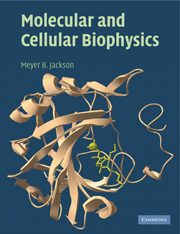Book contents
- Frontmatter
- Contents
- Preface
- Acknowledgements
- Chapter 1 Global transitions in proteins
- Chapter 2 Molecular forces in biological structures
- Chapter 3 Conformations of macromolecules
- Chapter 4 Molecular associations
- Chapter 5 Allosteric interactions
- Chapter 6 Diffusion and Brownian motion
- Chapter 7 Fundamental rate processes
- Chapter 8 Association kinetics
- Chapter 9 Multi-state kinetics
- Chapter 10 Enzyme catalysis
- Chapter 11 Ions and counterions
- Chapter 12 Fluctuations
- Chapter 13 Ion permeation and membrane potential
- Chapter 14 Ion permeation and channel structure
- Chapter 15 Cable theory
- Chapter 16 Action potentials
- Appendix 1 Expansions and series
- Appendix 2 Matrix algebra
- Appendix 3 Fourier analysis
- Appendix 4 Gaussian integrals
- Appendix 5 Hyperbolic functions
- Appendix 6 Polar and spherical coordinates
- References
- Index
Chapter 14 - Ion permeation and channel structure
Published online by Cambridge University Press: 24 May 2010
- Frontmatter
- Contents
- Preface
- Acknowledgements
- Chapter 1 Global transitions in proteins
- Chapter 2 Molecular forces in biological structures
- Chapter 3 Conformations of macromolecules
- Chapter 4 Molecular associations
- Chapter 5 Allosteric interactions
- Chapter 6 Diffusion and Brownian motion
- Chapter 7 Fundamental rate processes
- Chapter 8 Association kinetics
- Chapter 9 Multi-state kinetics
- Chapter 10 Enzyme catalysis
- Chapter 11 Ions and counterions
- Chapter 12 Fluctuations
- Chapter 13 Ion permeation and membrane potential
- Chapter 14 Ion permeation and channel structure
- Chapter 15 Cable theory
- Chapter 16 Action potentials
- Appendix 1 Expansions and series
- Appendix 2 Matrix algebra
- Appendix 3 Fourier analysis
- Appendix 4 Gaussian integrals
- Appendix 5 Hyperbolic functions
- Appendix 6 Polar and spherical coordinates
- References
- Index
Summary
Pure lipid bilayers have extremely low permeabilities to inorganic ions. Adding proteinaceous ion channels can increase the permeability by a factor of more than 108, allowing ions to flow across membranes and produce rapid changes in voltage. One can draw a strong analogy with enzymes. Both ion flow and the chemical reaction catalyzed by an enzyme have a favorable free energy that enables each to proceed in the absence of its respective catalyst, but at a very slow rate. Ion channels and enzymes both enhance these rates dramatically, and this enhancement is highly specific. In the case of an enzyme, small differences in the structure of a substrate can make a huge difference in catalytic efficiency. Likewise, ion channels can discriminate very effectively between different ions.
At first glance, an ion channel appears to have an easier task than an enzyme. It simply forms a water-filled pore so that ions see a continuous aqueous path through the membrane. However, a simple aqueous pore will not be specific for one particular ion. The diameter of K+ is 1.33 Å and the diameter of Na+ is 0.95 Å. Although this difference is small, some channels show selectivities between Na+ and K+ of more than 1000. Understanding this specificity is the real challenge in the study of ion channel permeation. Ion permeation depends not just on the water filling the pore but also on the detailed molecular structure of the protein that forms the channel.
- Type
- Chapter
- Information
- Molecular and Cellular Biophysics , pp. 367 - 399Publisher: Cambridge University PressPrint publication year: 2006



